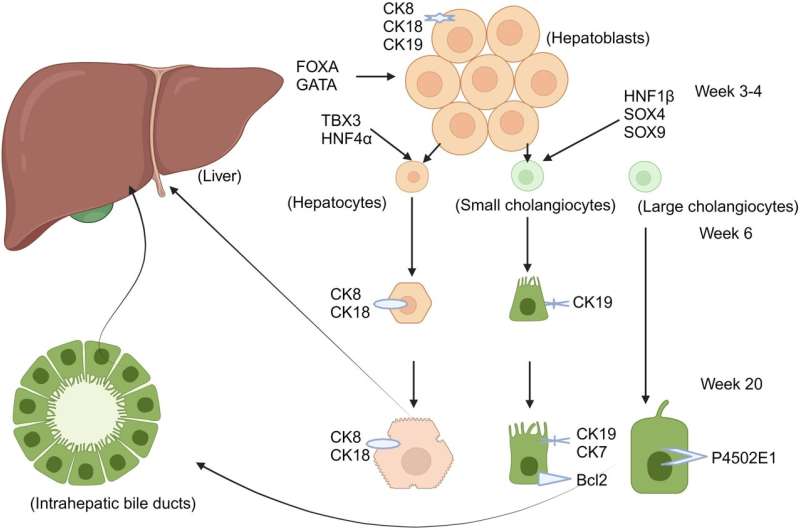This article has been reviewed according to Science X's editorial process and policies. Editors have highlighted the following attributes while ensuring the content's credibility:
fact-checked
proofread
Exploring the pathogenesis of autoimmune liver diseases from the heterogeneity of target cells

Autoimmune liver diseases (ALDs), including autoimmune hepatitis (AIH), primary biliary cholangitis (PBC), and primary sclerosing cholangitis (PSC), are complex conditions involving the liver's immune-mediated damage. These diseases are increasingly prevalent, but their pathogenesis remains largely unclear.
Published in the Journal of Clinical and Translational Hepatology, a review explores the role of cellular heterogeneity in understanding and potentially treating these conditions.
Heterogeneity in hepatocytes and bile duct epithelial cells
Hepatocytes and intrahepatic bile duct cells derive from hepatoblasts, whereas extrahepatic bile duct cells share developmental origins with the pancreas and duodenum. Hepatocytes display heterogeneity along the central vein-to-portal axis, marked by zonal distributions of key liver-gene expressions and homeostatic proliferation influenced by WNT and RSPO3 signaling from the central vein endothelium.
Autoimmune hepatitis (AIH)
AIH involves chronic liver inflammation, primarily targeting hepatocytes, leading to elevated serum aminotransferase levels, increased immunoglobulin G (IgG), and circulating autoantibodies. The autoimmune response in AIH may be triggered by molecular mimicry, where T cells mistakenly attack host proteins.
The presence of autoantibodies and antigen-specific cytotoxic T cells exacerbates liver damage. Decreased deoxyribonuclease I activity also plays a crucial role by reducing apoptotic cell clearance, thereby intensifying the autoimmune reaction. Key inflammatory mediators like interferon-gamma (IFN-γ) induce chemokine and adhesion molecule expression in hepatocytes, promoting inflammation and antigen presentation to T-helper (Th) cells and CD8+ T lymphocytes.
Primary biliary cholangitis (PBC)
PBC predominantly affects the epithelial cells of small bile ducts, leading to chronic intrahepatic cholestasis. Characterized by non-suppurative destructive cholangitis, PBC manifests with elevated alkaline phosphatase (ALP), γ-glutamyl transpeptidase (GGT), IgM levels, and anti-mitochondrial antibodies (AMAs). The chemokine C-X3-C motif chemokine ligand is implicated in bile duct damage, with epithelial cells exhibiting high proliferative activity to compensate for cell loss. Emerging data highlight the significant proliferative response of bile duct cells as a protective mechanism against specific liver injuries.
Primary sclerosing cholangitis (PSC)
PSC involves chronic inflammation and fibrosis of intra- and extrahepatic bile ducts, leading to stenosis and eventual occlusions. The exact pathogenesis remains elusive, but PSC is marked by a distinctive pattern of bile duct injury and inflammation. In PSC, bile duct cells display degenerative and atrophic features, contributing to disease progression. Research indicates that specific bile duct cell subsets can proliferate and differentiate into neuronal-like phenotypes in response to liver damage.
Role of microRNAs (miRNAs) in ALDs
MiRNAs are critical post-transcriptional gene regulators implicated in various autoimmune conditions, including ALDs. Specific miRNAs, such as miR-21, miR-122, and miR-155, correlate with the severity of AIH, influencing key pathogenic processes. Dysregulated miRNAs can serve as biomarkers for disease activity and hold potential for therapeutic modulation to restore immune tolerance and reduce autoimmune responses.
Application of single-cell RNA sequencing and spatial transcriptomics
The advent of single-cell RNA sequencing (scRNA-seq) and spatial transcriptomics has revolutionized our understanding of cellular heterogeneity in ALDs. These technologies allow for unprecedented resolution in identifying cell subpopulations and understanding intercellular communication mechanisms. By integrating scRNA-seq and spatial transcriptomics, researchers can map cell-type distributions and elucidate pathogenic mechanisms, paving the way for targeted therapeutic interventions.
Understanding the heterogeneity of target cells in ALDs provides new insights into their pathogenesis and potential treatment strategies. AIH, PBC, and PSC exhibit distinct cellular targets and inflammatory profiles, underlining the importance of personalized approaches in managing these diseases. Advances in technologies like scRNA-seq and spatial transcriptomics offer promising avenues for future research and clinical applications.
More information: Zi-Xuan Qiu et al, Exploring the Pathogenesis of Autoimmune Liver Diseases from the Heterogeneity of Target Cells, Journal of Clinical and Translational Hepatology (2024). DOI: 10.14218/JCTH.2023.00531


















